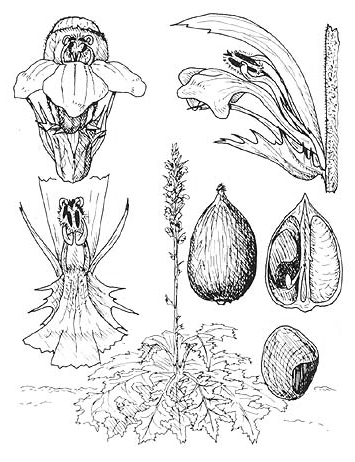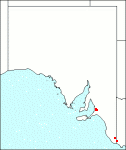Family: Acanthaceae
Acanthus mollis
Citation:
. aff. mollis, L., Sp. Pl. 639 (1753).
Synonymy: Not Applicable Common name: Bears breach.
Description:
Perennial with leaves in basal rosettes, forming a clump c. 0.5 m high and c. 1 m diam.; roots tuberous; leaves with reclining glabrous stiff petioles up to 20-30 cm long, the blade glossy, dark-green, glabrous, up to 50 x 30 cm, the margins divided or deeply lobed or toothed, the segments sometimes spine-tipped; scape up to 1 m high, devoid of flowers near the base and the first bracts often lacking flowers; rhachis glabrous; bracts cuneate at the base, 3-3.5 x c. 1 cm, finely pubescent all over, with 4 or 5 (rarely 7) spiny teeth on each side of the midrib and with 5 main veins arising from the base.
Bracteoles lanceolate, c. 2 cm long, pubescent; outer calyx lobes unequal, the upper functioning as the upper lip of the corolla and c. 4 cm long, the lower c. 3 cm long, both finely pubescent, entire and apically notched, purple or purple-tinged; inner calyx lobes ovate, c. 6 mm long, with an acute apex and pellucid margin; corolla c. 4-4.5 cm long, white; tube thickened at the top and with a dense ring of upright hairs at the point of insertion of the stamens, the hairs continuing onto the base of the lower lip and then continuing for a short distance onto the lateral lobes, the rest of the corolla glabrous; stamens with filaments c. 20-25 mm long; anthers purplish or brown, 8-10 mm long, the lower pair with long erect white hairs on either side of the suture, lacking sessile glands on the dorsal surface, the upper pair with shorter erect white hairs along one side of the suture and a line of villous white hairs to one side of the dorsal surface; ovary glabrous except for stiff white eglandular hairs at the very apex and on the base of the c. 3 cm long style.
Capsule c. 2 cm long, mucronate, this mucro with a few sparse hairs at the base, 1- or 2-seeded; seeds brown, c. 14 x 8 mm.

|
|
Image source: fig. 602 in Jessop J.P. & Toelken H.R. (Ed.) 1986. Flora of South Australia (4th edn).
|
|
|
Distribution:
|
Introduced from Europe as a garden plant, persistent in areas which were formerly gardens or found on roadsides. Probably spread by its persistent tuberous roots.
S.Aust.: SL, SE. ?Qld; Tas.
|
Conservation status:
naturalised
Flowering time: Oct. — Jan.
|

SA Distribution Map based
on current data relating to
specimens held in the
State Herbarium of South Australia
|
Biology:
No text
Taxonomic notes:
A. mollis and A. spinosus L. are both European species and are apparently very distinct at their extremes, but there are many intermediate forms between the 2 according to Rix (1980) The Plantsman 2:132. South Australian material differs from type material of A. mollis by its pubescent bracts and calyces, its glabrous peduncles and leaves and its incised rather than pinnatifid leaves. From A. spinosus it differs by its less prickly leaves and less incised leaves. As both species names are listed for early South Australian gardens it seems likely that the material persisting today represents some of the transitional forms between the species or are possibly of hybrid origin.
Author:
Not yet available
|

